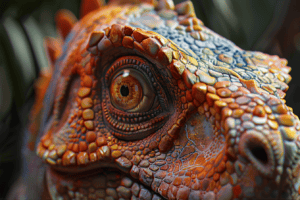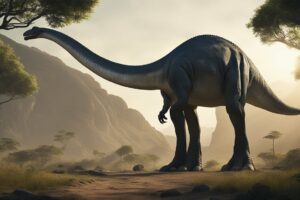Megaloceros, also known as the Giant Deer, was a majestic animal that roamed the earth thousands of years ago.
What made this species unique was its spectacular antlers, which were among the largest ever recorded in history.
The Megaloceros antlers were so massive that they could span up to 12 feet from tip to tip and weigh up to 88lbs.

These massive antlers were not only impressive to look at but also served an important purpose in the animal’s life.
The antlers were used by male Megaloceros to attract mates during the breeding season, and also to establish dominance over other males.
The females, on the other hand, had smaller and more slender antlers that were used for defense against predators and foraging for food.
Despite their impressive size, the Megaloceros antlers were not permanent and were shed annually, only to grow back even larger the following year.
The Megaloceros is an extinct species that has left behind many clues about its behavior, habitat, and eventual extinction.
Scientists have been studying the remains of this giant deer for many years, and their findings have shed light on the animal’s life and times.
Today, the Megaloceros remains an important part of our natural history, and its impressive antlers continue to fascinate and inspire people around the world.
Unveiling the Megaloceros
Megaloceros Giganteus, also known as the Irish Elk, was a species of deer that roamed the earth during the Pleistocene epoch.
These magnificent creatures were known for their massive antlers, which could span up to 12 feet from tip to tip.
Defining the Irish Elk
The Irish Elk was not actually an elk, but rather a species of deer that lived in Europe and Asia.
They were named “Irish” because many of the fossils were found in Ireland.
The scientific name, Megaloceros Giganteus, means “giant horn,” which is an apt description for these impressive animals.
Tracing the Evolutionary Tale
The Megaloceros Giganteus is believed to have first appeared about 400,000 years ago during the Pleistocene epoch.
They lived in a variety of habitats, from forests to grasslands, and were well adapted to cold climates.
Over time, the Megaloceros Giganteus evolved to become one of the largest deer species to have ever lived.
They could weigh up to 1,500 pounds, and their antlers could weigh up to 90 pounds.
Despite their impressive size, the Megaloceros Giganteus went extinct around 11,000 years ago.
The exact reason for their extinction is unknown, but it is believed to have been caused by a combination of factors, including climate change and hunting by early humans.
In conclusion, the Megaloceros Giganteus was a fascinating species of deer that roamed the earth during the Pleistocene epoch.
Their massive antlers and impressive size make them an intriguing subject for scientists and animal enthusiasts alike.
The Grand Stature and Antlers

Megaloceros, also known as the Giant Deer, was a magnificent creature that roamed the earth during the Pleistocene era.
Its most striking feature was its spectacular antlers, which could grow up to 3.5 meters in span!
Measuring Up the Giants
Megaloceros was one of the largest deer species that ever existed, standing over 2 meters tall at the shoulder.
Its size was comparable to that of a modern-day moose or elk, but with much larger antlers.
These antlers were not only impressive in size but also in complexity, with multiple tines and a palmate structure.
The Role of Antlers in Survival
Antlers play an important role in the survival of deer species.
They are primarily used for sexual selection, as male deer use their antlers to fight for dominance and access to mates.
The larger and more impressive the antlers, the more likely a male is to win these battles.
But antlers also serve other purposes. They can be used for defense against predators, such as wolves or bears.
They can also be used to attract females during mating season, as the sound of two males clashing their antlers can be heard from far away.
Interestingly, Megaloceros was not actually an elk, despite its common name of “Irish Elk.” It was a species of deer, and its closest living relative is the fallow deer.
Overall, Megaloceros was a fascinating creature with an impressive set of antlers that played a crucial role in its survival.
Its grand stature and unique features make it a captivating subject for anyone interested in the natural world.
Fun Fact: Did you know that Megaloceros went extinct about 7,660 years ago?
Habitats and Habits

From Forests to Grasslands
Megaloceros, also known as the Irish Elk, was a majestic deer that roamed the grasslands, forests, and wetlands of Europe and Asia.
These giant deer were found in habitats ranging from the cold tundra of Eurasia to the lush forests of Ireland.
They were well adapted to living in different environments and could be found in a variety of ecosystems.
Megaloceros was a herbivore, and their diet consisted of leaves, grasses, and other vegetation.
They were known to feed on a wide variety of plants, including willow, birch, and elm.
These giant deer were able to browse on high tree branches and reach leaves that other animals could not.
They were also able to graze on grasses in open meadows.
Diet and Daily Life
Megaloceros had a unique set of features that helped them survive in the wild.
They had large antlers, which were used for defense against predators and for attracting mates.
These antlers could reach up to 12 feet in length and were the largest of any deer species.
Despite their size, these antlers were shed and regrown every year.
Megaloceros was a social animal and lived in herds. These herds could contain anywhere from a few individuals to several hundred.
They were most active during the day and spent their time feeding, resting, and socializing.
Fun fact: Did you know that Megaloceros was not actually an elk? Despite its name, it was a type of deer that lived during the Pleistocene epoch.
Overall, Megaloceros was a fascinating animal that lived in a variety of habitats and had unique adaptations that helped it survive in the wild.
Extinction and Its Echoes

Climate’s Cruel Twist
The extinction of the Megaloceros, also known as the Irish elk, was influenced by many factors, including climate change and hunting by humans.
During the last ice age, the Megaloceros thrived in Europe, Asia, and North Africa.
However, as the climate began to warm and the ice melted, the environment changed, and the Megaloceros struggled to survive.
The changing climate led to a decrease in the availability of food, which put pressure on the Megaloceros population.
As a result, the Megaloceros became extinct about 11,000 years ago.
Interactions with Humans
Humans also played a role in the extinction of the Megaloceros.
As the human population grew, hunting became more prevalent, and the Megaloceros was a popular target.
Humans hunted the Megaloceros for its meat, fur, and antlers, which were used for tools and decoration.
The combination of climate change and hunting put too much pressure on the Megaloceros population, and it eventually went extinct.
Fossils and specimens of the Megaloceros have been found all over the world, including in peat bogs, caves, and other locations.
These fossils and specimens provide valuable information about the Megaloceros and its way of life.
Scientists have been able to study the bones and teeth of the Megaloceros to learn about its diet, behavior, and habitat.
They have also been able to reconstruct the animal’s appearance and size.
Today, the echoes of the Megaloceros can still be seen in the animal kingdom.
The elk, moose, and other deer species that exist today are all distant relatives of the Megaloceros.
The Megaloceros may be gone, but its legacy lives on in the animals that it helped to evolve.
Frequently Asked Questions

How large were the antlers of the Irish elk compared to modern deer?
The antlers of the Irish elk, also known as Megaloceros, were massive, and the largest ever recorded on any deer species.
The antlers could grow up to 12 feet wide, weighing up to 90 pounds!
In comparison, modern deer species such as the white-tailed deer have antlers that grow up to 3 feet wide.
It’s hard to imagine how the Irish elk could carry such massive antlers, but scientists believe that they had evolved a strong neck and shoulder muscles to support the weight.
What era did the Megaloceros roam the Earth, and when did it go extinct?
The Megaloceros lived during the Pleistocene epoch, which lasted from about 2.6 million to 11,700 years ago.
They roamed across Europe, Asia, and North Africa, and were one of the largest animals in their ecosystem.
Unfortunately, the Megaloceros went extinct at the end of the last Ice Age, around 10,000 years ago.
Scientists believe that climate change, hunting by early humans, and competition for resources with other animals contributed to their extinction.
What was the diet of the giant deer, and how did it sustain its massive size?
The Megaloceros was a herbivore, and its diet consisted mainly of grasses, leaves, and other plant matter.
They were able to sustain their massive size by eating large amounts of food and having a slow metabolism.
They also had a unique digestive system that allowed them to extract more nutrients from their food than modern deer species.
Can you find Irish elk antlers for sale, and are they legally obtainable?
It is illegal to sell or buy Irish elk antlers, as they are a protected species.
The only way to obtain them is through museums, scientific institutions, or private collections that have been legally obtained.
What are some theories behind the extinction of the Irish elk?
There are several theories behind the extinction of the Irish elk.
One theory suggests that the Megaloceros went extinct due to climate change, which caused a decline in their food sources.
Another theory suggests that they were overhunted by early humans, who used their antlers for tools and weapons.
Competition with other animals for resources may have also contributed to their extinction.
Did the Megaloceros have a seasonal antler shedding cycle like modern deer?
Yes, the Megaloceros had a seasonal antler shedding cycle like modern deer.
Male Megaloceros would grow a new set of antlers each year, which they would use to attract mates and establish dominance.
After the mating season, the antlers would shed, and the process would repeat itself the following year.







